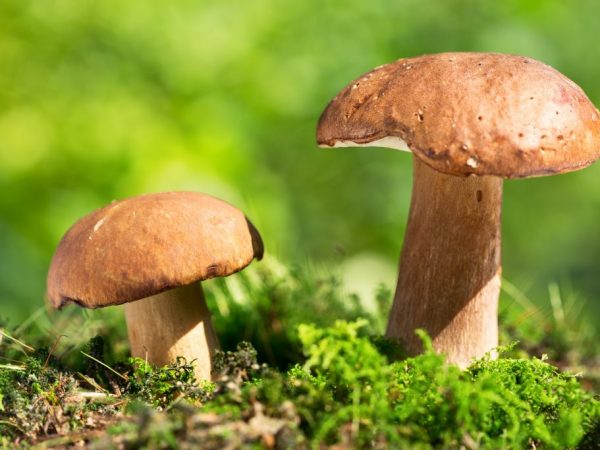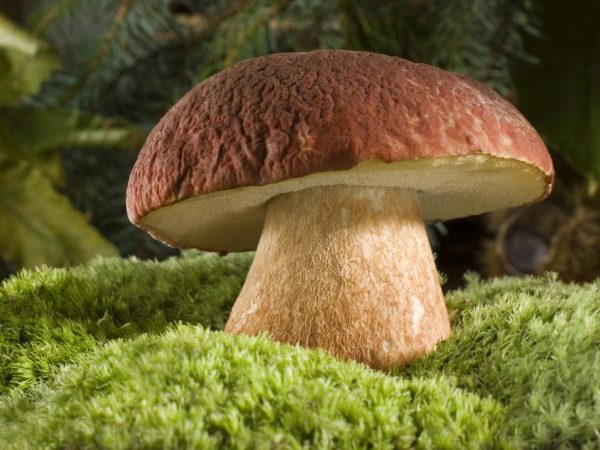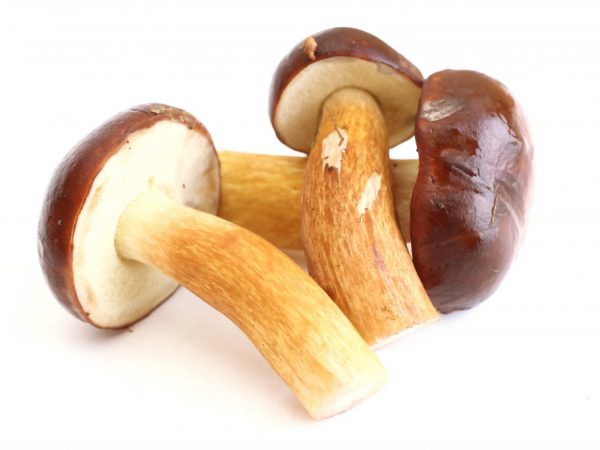Description of mushrooms boletus
One of the most delicious, valuable and generous gifts of the forest is boletus mushrooms. There are about fifty varieties of these mushrooms, but not all of them are equally suitable for use in food. It is useful for novice mushroom pickers to know what a butter dish looks like, where and when it grows, what properties it has and how it differs from its inedible counterparts.

Description of mushrooms boletus
Characteristic
A distinctive feature of the oiler is the oily film on the cap, which should be cleaned before cooking. The genus to which the boletus belongs is called the Oiler.
Butter mushrooms are medium-sized mushrooms, only overripe (overgrown) are large. The color of the cap varies from yellow to brown (there are varieties of other colors - white, gray, reddish-red, etc.). The spore-bearing layer of the fungus, the hymenophore, has a tubular structure.
The butter dish has a dense white or yellowish flesh (in some varieties, it turns blue or red when cut). The smell of the pulp is neutral or with notes of pine needles. Usually, this delicate type of mushroom ages quickly (in almost a week) and often turns out to be wormy. Therefore, it is preferable to collect young specimens.
Boletus grows in Russia, Ukraine, Belarus, Czech Republic, America, many European and Asian countries (in the zone of forests and forest-steppe, as well as in the steppe zone - in forest plantations).
Chemical composition
This product contains a lot of protein (even more than the "king" mushrooms - porcini and milk mushrooms). The oil contains many useful microelements: iron, copper, potassium, iodine, zinc, phosphorus, manganese, etc. Mushrooms contain B vitamins, as well as vitamins D, A, C, PP. At the same time, the calorie content of this type does not exceed 20 kcal per 100 g, which makes it possible to use them in the presence of a diet for those who want to lose weight. However, do not forget that this is the calorie content of fresh, i.e. not cooked product. Butter oils are good for the heart and nervous system, help in the treatment of migraines, gout, and infectious diseases.
Where and when to collect
The coniferous forest will be the best place to collect oil mushrooms. These species love sandy soil, do not like too humid places and dense thickets without access to light. Sometimes they are found in birch groves and under oak trees. Boletus grows in meadows or forest edges, in clearings, along paths - in groups (in the form of snakes) or one at a time.
The first butterflies appear at the very beginning of summer, during the flowering of the pine (sometimes they begin to grow in the month of May). In July, they run in parallel with the linden blossom. The third flow of boletus begins in August and continues until the end of autumn. When the soil freezes 2 cm deep, the mushrooms disappear.
Edible species
Types of edible mushrooms:
- Ordinary butter dish (autumn oilcan, yellow oilcan, real oilcan, late oilcan): at a young age, it has a hemispherical hat, which then opens and becomes almost flat.The skin on the cap separates well from the pulp. An ordinary oiler grows in autumn - in September and October. He needs cleaning and cooking (frying, boiling, marinating, etc.).
- Oiler Trident (red & red): possesses a fleshy cap, the color of which ranges from orange to red. When cut, the flesh of the mushroom turns reddish. This species grows from July to the end of October. Prefers mountain slopes covered with coniferous vegetation. This type is a Trident oiler, it is used for food, like an ordinary oiler, but in terms of taste it belongs to category 2 mushrooms.
- Granular butter dish (summer early): by its external characteristics (description) it resembles the previous species, but its cap has a less bright color. On the leg of a summer oilcan, droplets of solidified liquid are visible, which is released by the pores and becomes dark in color, which served as the basis for the name. Granular oiler appears in the forest in June and grows until November. To easily clean this mushroom, it is recommended to pour over it with boiling water. Granular butter dish is an edible mushroom with a pleasant nutty flavor and aroma.
- Bellini Oiler: the mushroom has a hemispherical brown or white cap. The tubular layer is greenish and dense, becomes loose with age. Bellini mushroom pulp is white, aromatic and pleasant to the taste. Bellini's oiler prefers spruce or pine forests. They begin to collect it from September.
- Oiler white: belongs to the group of edible mushrooms, but its taste and smell are neutral. The white cap of such mushrooms becomes olive green when it rains. The pulp is white or yellowish, at the cut point it turns slightly red. This mushroom usually coexists with pines and cedars. Collecting it begins in early summer and continues until November.
- Larch oil can: grows only under larch or in forest areas with its presence. It is a mushroom with an orange-golden cap, which is rather flat than convex. The peel from the cap is very difficult to remove. The tubular layer in young butters is covered with a film, the pulp is juicy with visible fibers. Larch butterdish begins to grow in July and disappears at the end of September. Good for food, but considered a category 2 mushroom.
- Red oil can: it is a bright mushroom with a reddish gummy cap. They begin to collect it from the beginning of summer and continue almost until the first frost. Like the larch oil can, this mushroom often coexists with larch. It can also be found in coniferous and mixed forests. It is a tasty and aromatic mushroom, rarely wormy and suitable for all types of culinary processing.
Conditionally edible species

Treat mushrooms thoroughly before eating
Conditionally edible mushrooms include mushrooms of lower palatability, for which thorough cleaning and cooking are required.
- Swamp oil can (yellow-brown, sandstone): has a semicircular cap, which becomes like a flat pillow with age. The color of the cap is brown, olive or orange. The yellow flesh of the marsh oiler turns blue when cut, interacts with air. This mushroom grows from July to the end of September. The skin is separated with parts of the pulp.
- Siberian butter dish: it is distinguished by a cushion-shaped cap of yellow-olive color. Sometimes brownish fibers are visible on it. The mushroom is found in the coniferous forests of Siberia, more often under cedars. The Siberian species of boletus is harvested in August and September. This is a delicious mushroom with a slight sourness, although it belongs to conditionally edible.
- Goat (dry oiler, trellis, kid): has a neutral taste, belongs to the 3rd category. The goat and the oiler belong to the same Boletov family. The first is distinguished by a longer stem and a dry cap. Sometimes the goat is called “dry butterdish”. It is harvested in July and August in coniferous forests.
- Oiler gray: it is distinguished by a yellowish-gray or olive-gray color of the cap and a tubular layer of a similar shade. This mushroom is sticky not only with a cap, but also with a leg. At the cut site, the pulp turns blue. The mushroom grows in coniferous and deciduous forests from early summer to October. The pulp of the mushroom has a watery structure and a neutral taste, therefore it is ranked in category 3 and in the group of conditionally edible.
- Yellowish butter dish: It has a small slippery cap (4-6 cm in diameter) and a white leg with a characteristic oily ring. The color of the cap is ocher-yellow, gray-yellow or brown-yellow. According to the description, it is similar to the Siberian type of butterdish, but differs in the presence of a mucous ring on the leg. Grows in coniferous forests from late May to late November. It is classified as a conditionally edible mushroom due to its weak taste.
Inedible species
Inedible species are sometimes referred to as pepper oil can - it is not poisonous, but has a sharp, bitter taste. The cap of the pepper mushroom is light brown, dryish and slightly velvety to the touch. The stem is often curved and of the same color as the cap. The pulp has a loose structure and turns slightly red when broken or cut.
Pseudo-butter mushrooms are sometimes called mushrooms that look like real boletus. However, there are always significant differences between them - the boletus do not have completely identical poisonous twins. At first glance, you can take other mushrooms for them that have a similar cap (for example, meadow hygrophor or panther fly agaric).
Never forget: if a lamellar rather than a tubular layer is visible under the cap of the mushrooms, these are fake butter oils and cannot be taken. A suspicious sign is a bluish, grayish or too pale color of the cap, as well as a strong fragility of the mushroom.
Cooking applications
Oils are suitable for all types of processing: pickling, frying, boiling, stewing and baking. Young mushrooms harvested in late summer or early autumn have the best taste and greatest benefits. Late autumn harvest is also successful, but by this time some mushrooms may freeze, overripe and become too watery. Before cooking, the mushrooms are cleaned and washed thoroughly. Flushing oil does not mean soaking. Their tubular hymenophore easily absorbs and retains large amounts of water. Therefore, it is better to rinse the mushrooms under running water.
Irina Selyutina (Biologist):
How the boletus should be cleaned depends on the weather conditions under which these mushrooms were harvested:
- if the weather is dry and sunny: start cleaning immediately upon returning from the forest;
- if the weather is rainy: the mushrooms need to be dried a little on a newspaper spread out on the floor or table.
Next, you should decide how you are going to make butter from oil:
- Drying: simply remove debris from the surface with a stiff bristled brush; scrape off dirty places on the leg (if any) with a sharp knife or cut off; wipe with a soft cloth.
- Heat treatment: in this case, removing the film is mandatory.
- Freezing: clean fresh ones as before drying, but raw mushrooms take up a lot of space in the freezer, so they are pre-boiled or fried.
Fresh mushrooms (without processing) are stored in the refrigerator for 10-12 hours. They can be placed on the lower shelf without airtight packaging, because mushrooms need to provide a constant supply of fresh air. Otherwise, they will become unusable.
The main rule of processing, which should not be forgotten, is to completely remove the slippery film on the oil caps. If this is not done, the mushrooms will turn black and unappetizing when preserved or cooked. A film of conditionally edible oil sometimes contains toxins and can harm the body - from diarrhea to stomach diseases. If the film does not come off, pour boiling water over the mushrooms before cleaning.
Butterlets go well with meat, potatoes, most vegetables and spices.Before adding to soup, stews or baked dishes, it is better to fry the mushrooms in sunflower oil with the addition of onions.
Procurement rules

Oils are versatile in use
Boletus mushrooms collected in the fall are harvested for the winter: canned, dried or frozen. Before conservation, the mushrooms must be boiled for half an hour. If we preserve young boletus mushrooms, it is better to leave them intact, and if overgrown specimens come across, we cut them into pieces, not forgetting to remove the damaged areas, and discard the wormy mushrooms altogether. This type of mushroom is dried not as often as porcini or aspen mushrooms (before drying, the slippery film of oil is not removed and the mushrooms turn black after drying). Despite this, drying oil is quite justified - in dried form, they retain most of the vitamins, essential oils and nutrients.
Frozen boletus is an excellent option for replenishing the winter stock. Before freezing, the mushrooms are cleaned, washed and dried. The oil is put in a bag or plastic container and sent to the freezer. Alternatively, boiled mushrooms are sometimes frozen. In frozen form, the mushrooms will lie for as long as you like - all winter and spring, right up to the new mushroom season.
Benefits for children
Due to its rich chemical composition, boletus is useful for children, but there are some rules for introducing them into a children's diet:
- Up to 7 years old, these mushrooms (like other forest ones) are contraindicated.
- Ten-year-old children are given boletus separately, but in small portions and no more than once a week.
- The children's diet should include only young mushrooms collected in ecologically clean areas, away from industrial enterprises.
- Fried and pickled mushrooms cannot be combined with flour dishes - such a combination of products is difficult for the stomach to digest.
The reason for this is chitin, which is poorly absorbed by the body.
Contraindications
Mushrooms are a heavy food, the abuse of which can harm even a healthy person. People with diseases of the digestive organs should be especially careful. During periods of exacerbation of such diseases, you cannot eat mushrooms. Also, caution is needed for diseases of the kidneys and liver, during pregnancy and breastfeeding.
In some cases, boletus can cause an allergic reaction. Improperly cooked mushrooms can lead to eating disorders. For greater safety, boil the butter for at least half an hour before any further processing. In addition, the mushrooms need to be finely chopped to make them easier for the stomach to absorb.
Recommendations
- Novice mushroom pickers should take only those types of edible butter that have a classic mushroom taste (common butter dish, granular butter dish, etc.).
- It is necessary to clean and process mushrooms immediately after harvesting (preferably on the same day).
- It is better to clean mushrooms with gloves. The brownish substance secreted by these fungi sticks to the skin and is difficult to wash off.
- It is better to pick butter and other mushrooms in the early morning, when the sun does not blind your eyes - this way the mushrooms are better seen.
It is interesting
- In the old days in Russia, boletus was not collected due to the fact that the forests were full of mushrooms of the highest category - milk mushrooms, saffron milk caps, white mushrooms. But with the reduction in the volume of forests, the number of "elite" mushrooms also decreased. Mushroom pickers paid attention to butter and appreciated their taste at their true worth. This is evidenced by the name itself - "boletus". It shows that the slippery cap of mushrooms was associated in people with delicious dishes cooked in oil, and not with mucus (inedible slippery mushrooms have less cute names, for example - "slug" or even "jerk").
- Sometimes the mycelium is transplanted together with several layers of earth and moss (for example, in a fire in the forest, when in a certain place the mycelium burns out and it is necessary to dilute them again).
- These mushrooms live in cooperation with the tree under which they grow. This phenomenon is called "mycorrhiza". The mycelium and the roots of the tree form a kind of union in which the hyphae of the fungus penetrate into the root and exchange nutrients. Most often, pine, larch or different types of cedars become such a tree for butter.
- If you dream of boletus, soon your painstaking work will achieve recognition, will be highly appreciated and worthy of reward.
Conclusion
Butterlets are one of the most delicious and healthy mushrooms that grow abundantly in our region every summer and autumn. However, for effective and safe "mushroom hunting", novice mushroom pickers should learn: what different types of boletus mushrooms look like, where they grow and at what time they need to be collected. In addition, you need to remember the signs of inedible mushrooms - both poisonous and simply tasteless.



